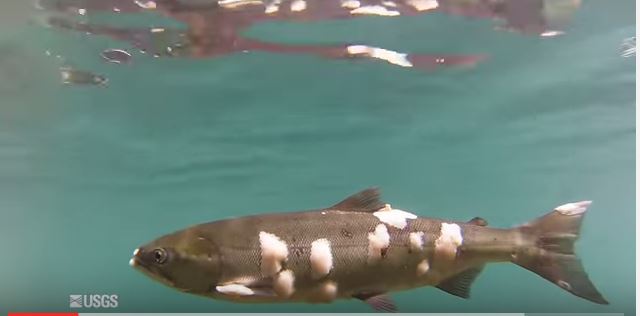forum
library
tutorial
contact

Sockeye Begin Return as Above
Normal Water Temps Persist
by Laura Berg
NW Fishletter, June 6, 2016
|
the film forum library tutorial contact |

|
Sockeye Begin Return as Above
by Laura Berg
|
 Fish managers are closely monitoring higher-than-average water temperatures in the Columbia and Snake river systems as adult sockeye start their upstream journey to spawning areas.
Fish managers are closely monitoring higher-than-average water temperatures in the Columbia and Snake river systems as adult sockeye start their upstream journey to spawning areas.
As of June 1, more than 700 sockeye had passed Bonneville Dam, slightly above the 10-year average for that date. Temperatures, too, were above the 10-year average. The June 1 reading at the Bonneville Dam forebay was 60.6 degrees, eclipsing the 10-year average for that date of 57.9 degrees.
Temperatures at most of the Columbia and Snake river dams have been at or above normal levels, similar to the disastrous sockeye run of 2015.
The three-month forecast for the Northwest is for above-normal air temperatures, while water supply data shows the region's runoff is above average and much of remaining snowpack is below normal.
By the end of June 2015, sockeye, summer Chinook and steelhead adults and sturgeon were dying in the Columbia and Snake system because water temperatures exceeded 68 degrees, which is considered lethal to cold-water fish.
Meeting via conference call May 26, fish agencies and tribes discussed preparations for fish migrating into warmer water in 2016 and beyond.
Fish managers seemed to agree that it would be a good idea to a set a water-temperature trigger below 68 degrees that would initiate emergency actions before fish start dying.
Such a system is in place in the Klamath River Basin in southern Oregon and northwestern California. And according to representatives from the basin who were on the conference call, it's working.
The Klamath Fish Health Assessment Team provides early warning and a coordinated response to prevent or address anadromous fish kills caused by low flow and high temperature events in the Klamath basin.
The multi-agency Klamath team uses a color-coded system to assess risk. As risk increases, members step up their communication and information exchange, recommend management actions, and finally, implement a response plan.
The response plan's "main focus is adding water to the [Klamath] system and curtailing agricultural withdrawals," according to the team's website.
For the Columbia and Snake systems, the Fish Passage Center and Fish Passage Advisory Committee (FPAC) collect and use in-season indicators, such as water temperatures, adult counts, PIT-tag detections and conversion rates (survival through mainstem Columbia and Snake reservoirs and dams) to identify potential problems.
At a recent FPAC meeting, members said the Columbia-Snake region needs better coordination once problems are identified, a suggestion that seemed to be endorsed by those attending the phone conference.
Aside from the systemwide releases of water from federal storage dams that were undertaken last year, other recommended management strategies included starting trap-and-haul operations sooner than was done in 2015 and at additional locations.
Trap-and-haul could be initiated at predetermined temperature criteria, it was suggested.
Last year, such operations occurred at Lower Granite Dam, saving a small but significant number of endangered Snake River sockeye.
U.S. fisheries entities along with Canadian agencies and First Nations are making preparations to trap sockeye at Wells Dam and haul them to the upper Okanogan to spawn in Lake Osoyoos, which is located in both Washington and British Columbia.
The cooperating entities are, however, encountering regulatory problems with their plans to truck fish across the international border.
Another proposal for longer term actions is to overlay climate-change models with the location of fish kills "to improve the ability to forecast where and how often low flows and high temperatures might affect fish, then develop place-specific mitigation plans," the Northwest Power and Conservation Council said in a posting that also mentions other recommendations for an early warning system.
The Council convened the conference call of more than 30 fish agency and tribal representatives to continue discussions happening in other interagency forums for fish and hydrosystem operations, including the Technical Management Team, Fish Passage Operations Maintenance, and the Fish Passage Advisory Committee.
learn more on topics covered in the film
see the video
read the script
learn the songs
discussion forum
